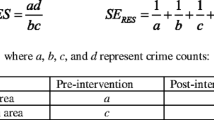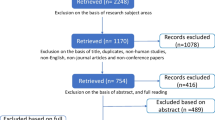Abstract
While the relationship between women’s fear of crime and public space has been the focus of considerable research, transit environments have received less attention. This study examines women’s safety in transit environments through a comprehensive review of the literature and in-depth interviews with representatives of 16 national women’s interest groups in the United States. It finds that women have distinct safety/security needs, are often fearful of certain transit environments and frequently adjust their behaviour and travel patterns to avoid them. This is particularly true for certain groups of women who feel more vulnerable to victimization and harassment than others. The women interviewed outlined design, policing, security technology and education/outreach strategies that would make women riders feel safer in transit settings.

Similar content being viewed by others
Notes
Transport for London (TfL) has initiated plans targeting the needs of women riders. In Mexico City, the municipal government started the WE TRAVEL SAFE programme in 2007, with the goal to prevent physical and sexual violence in the city’s public transportation system. In Canada, a number of municipal governments have funded METRAC to train community and women’s groups to conduct safety audits of transportation settings. In 2005, The Government of South Australia’s Minister for the Status of Women launched a programme called Our Commitment to Women’s Safety, which focuses on improving the safety and security of transportation settings.
In safety audits, women walk around a transportation setting or public environment noting their fears and concerns and making suggestions for improved safety.
The ‘fishbowl effect’ describes the situation where a bus shelter is brightly lit, but the surrounding environment is dark. In such a case the passenger is seen, but he/she is unable to see others outside the bus shelter.
Gender mainstreaming denotes the integration of a gender perspective in policy processes with the goal of promoting equality of men and women.
References
Alexander, C. and Pain, R. (2012) Urban security: Whose security? Everyday responses to fears. In: V. Ceccato (ed.) The Urban Fabric of Crime and Fear. New York and London: Springer.
Atkins, S. (1989) Critical Paths: Designing for Secure Travel. London: Design Council.
Austin, T. and Buzawa, E. (1984) Citizen perceptions on mass transit crime and its deterrence: A case study. Transportation Quarterly 38 (3): 103–120.
Best, A. (2013) Transit violations: Locating the ‘bus rape’ in L.A. and other public geographies of violence. The Feminist Wire,http://thefeministwire.com/2013/02/transit-violations-locating-the-bus-rape-in-l-a-and-other-public-geographies-of-violence/, accessed 21 June 2013.
Boyd, A. and Boyd, P. (1998) Transit Security Handbook. Report FTA-MA-90-9007-98-1, DOT-VNTSC-FTA-98-4, FTA Washington DC: US Department of Transportation.
Brownson, R.C., Baker, E.A., Houseman, R.A., Brennan, L.K. and Bacak, S.J. (2001) Environmental and policy determinants of physical activity in the United States. American Journal of Public Health 91 (12): 1995–2003.
Carter, M. (2005) Gender differences in experience with and fear of crime in relation to public transport. In: Research on Women’s Issues in Transportation. Vol. 2. Conference Proceedings 35, Washington DC: Transportation Research Board, p. 100.
Church, A., Frost, M. and Sullivan, K. (2000) Transport and social exclusion in London. Transport Policy 7 (3): 195–205.
Clancy, A., Hough, M., Aust, R. and Kershaw, C. (2001) Policing and Justice: The Experience of Ethnic Minorities – Findings from the 2000 British Crime Survey. London: Home Office.
Craig, C.L., Brownson, R.C., Craig, S.E. and Dunn, A.L. (2002) Exploring the effect of the environment on physical activity: A study examining walking to work. American Journal of Preventive Medicine 23 (2): 36–43.
Cresswell, T. and Uteng, T.P. (2008) Gendered mobilities: Towards a holistic understanding. In: T.P. Uteng and T. Cresswell (eds.) Gendered Mobilities. London: Ashgate, pp. 1–14.
Department for Transport. (1997) Crime Concern and Transport and Travel Research: Perceptions of Safety from Crime on Public Transport. London: Department for Transport.
Department for Transport. (2002) People’s Perception of Personal Security and Their Concerns about Crime on Public Transport: Literature Review. London: Department for Transport.
Department for Transport. (2004) People’s Perception of Personal Security and Their Concerns about Crime on Public Transport: Research Findings. London: Department for Transport.
Dunckel-Graglia, A. (2013) Women-only transportation: How ‘pink’ public transportation changes public perception of women’s mobility. Journal of Public Transportation 16 (2): 85–106.
Giuliano, G. (1979) Public transportation and the travel needs of women. TrafficQuarterly 33 (4): 607–616.
Gordon, M. and Riger, S. (1989) The Female Fear. New York: The Free Press.
Ingalls, G., Hartgen, D. and Owens., T. (1994) Public fear of crime and its role in bus transit use. Transportation Research Record (1433): 201–211.
Khimm, S. (2006) Warning: No-groping zone, http://www.alternet.org/story/35753/warning%3A_no-groping_zone, accessed 6 June 2006.
Koskela, H. (2000) ‘The gaze without eyes’: Video-surveillance and the changing nature of urban space. Progress in Human Geography 24 (2): 243–265.
Law, R. (1999) Beyond ‘women and transport’: Towards new geographies of gender and daily mobility. Progress in Human Geography 23 (4): 567–588.
Larsen, V. and Topsøe-Jensen, H. (1984) Urban Planning and the Everyday Life of Women. Hørsholm, Denmark: Danish Building Research Institute, Urban and Regional Planning Division.
Loukaitou-Sideris, A. (1999) Hot spots of bus stop crime: The importance of environmental attributes. Journal of the American Planning Association 65 (4): 395–411.
Loukaitou-Sideris, A. (2005) Is it safe to walk here? Design and policy responses to women’s fear of victimization in public places. In: Research on Women’s Issues in Transportation. Vol. 2, Conference Proceedings 35, Washington DC: Transportation Research Board, pp. 102–112.
Loukaitou-Sideris, A. (2006) Is it safe to walk? Neighborhood safety and security considerations and their effects on walking. Journal of Planning Literature 20 (3): 219–232.
Loukaitou-Sideris, A. (2009) How to Ease Women’s Fear of Transportation Environments: Case Studies and Best Practices. Report 09-01 San Jose, CA: Mineta Transportation Institute.
Loukaitou-Sideris, A. and Fink, C. (2009) Addressing women’s fear of victimization in transportation setting: A survey of US transit agencies. Urban Affairs Review 44 (4): 554–587.
Lucas, K. (2010) Transport and social exclusion: Where are we now? 12th WCTR, 11–15 July – Lisbon, Portugal, http://www1.caminos.upm.es/music1/files/04_seminarios/1_Sem/05/descargas/5_Transport_Exclusion_Karen%20Lucas.pdf, accessed 4 September 2013.
Lynch, G. and Atkins, S. (1988) The influence of personal security fears on women’s travel patterns. Transportation 15 (3): 257–277.
Metropolitan Action Committee on Violence Against Women and Children (METRAC). (2006) Why women’s safety? http://www.metrac.org/programs/safe/why.htm, accessed 16 October 2007.
Morrell, H. (1996) Women’s safety. In: C. Booth, J. Darke and S. Yeandle (eds.) Changing Places: Women’s Lives in the City. London: Sage.
Needle, J.R. and Cobb, M. (1997) Improving Transit Security. Transit Cooperative Research Program Washington DC: National Academy Press.
Pain, R. (2001) Gender, race, age, and fear in the city. Urban Studies 38 (5/6): 899–914.
Polk, M. (2008) Gender mainstreaming in Swedish transport policy. In: T.P. Uteng and T. Cresswell (eds.) Gendered Mobilities. London: Ashgate, pp. 229–242.
Reed, T.B., Wallace, R.W. and Rodriguez, D.A. (1999) Transit passenger perceptions of transit-related crime reduction measures. Transportation Research Record (1731): 130–141.
Romero, S. (2013) Public rapes outrage Brazil, testing ideas of image and class. New York Times. 25 May, http://nytimes.com/2013/05/25/world/americas/rapes-in-brazil-spur-class-and-gender-debate.html, accessed 20 June 2013.
Rosenbloom, S. (1978) Editorial: The need for study of women’s travel issues. Transportation 7 (4): 347–350.
Rosenbloom, S. (1995) Travel by women. In: Demographic Special Reports (1990 NPTS Publication Series), FHWA, US Department of Transportation, pp. 2-1–2-57.
Ross, C.E. (2000) Walking, exercising, and smoking: Does neighborhood matter? Social Science and Medicine 51 (2): 265–274.
Scarborough Women’s Centre/METRAC. (1991) Making Transit Stops Safer for Women: Scarborough Moves Forward. Scarborough, Canada: Scarborough Women’s Centre/METRAC.
Schulz, D. and Gilbert, S. (1996) Women and transit security: A new look at old issues. In: Women’s Travel Issues Second National Conference. Washington DC: Federal Highway Administration.
Seefeldt, V., Malina, M.R. and Clark, M.A. (2002) Factors affecting levels of physical activity in adults. Sports Medicine 32 (3): 143–168.
Smith, M.J. (2008) Addressing the security needs of women passengers on public transport. Security Journal 21 (1–2): 117–133.
Smith, W. and Torstensson, R. (1997) Gender differences in risk perception and neutralizing fear of crime: Toward resolving the paradoxes. British Journal of Criminology 37 (4): 608–634.
Stanko, E. (1990) Everyday Violence: Women’s and Men’s Experience of Personal Danger. London: Pandora.
Stringer., S.M. (2007) Hidden in plain sight: Sexual harassment and assault in the New York City Subway System, http://www.nytimes.com/packages/pdf/nyregion/city_room/20070726_hiddeninplainsight.pdf, accessed 2 October 2008.
Tanzarn, N. (2008) Gendered mobilities in developing countries. In: T.P. Uteng and T. Cresswell (eds.) Gendered Mobilities. London: Ashgate.
TRANSGEN. (2007) Gender Mainstreaming European Transport Research and Policies. Copenhagen, Denmark: Coordination for Gender Studies, University of Copenhagen.
Transport for London (TfL). (2004) Expanding Horizons: Transport for London’s Women’s Action Plan. London: Transport for London (TfL).
Trench, S., Oc, T. and Tiesdell, S. (1992) Safer cities for women: Perceived risks and planning measures. Town Planning Review 63 (3): 279–293.
Uteng, T.P. (2009) Gender, ethnicity, and constrained mobility: Insights into the resultant social exclusion. Environment and Planning A 41 (5): 1055–1071.
Valentine, G. (1990) Women’s fear and the design of public space. Built Environment 16 (4): 288–303.
Valentine, G. (1996) (Re)negotiating the ‘heterosexual street’: Lesbian production of space. In: N. Dunkan (ed.) Body Space: Distabilizing Geographies of Gender and Sexuality. London: Routledge.
Wallace, R.R., Rodriguez, D.A., White, C. and Levine, J. (1999) Who noticed, who cares? Passenger reactions to transit safety measures. Transportation Research Record (1666): 133–138.
Wekerle, G. and Whitzman, C. (1995) Safe Cities: Guidelines for Planning, Design and Management. New York: Van Nostrand Reinhold.
Whitzman, C., Legacy, C., Andrew, C., Klodawsky, F., Shaw, M. and Viswanath, K. (2012) Building Inclusive Cities: Women’s Safety and the Right to the City. London: Routledge.
Women’s Planning Network Inc. (1995) Women’s Transport Needs. Victoria, Australia: Women’s Planning NetworkInc, July.
List of Interviews
Andrew, C. Board President, Montreal, Canada, Women in Cities International.
Burkhardt, P. Legislative Officer, Washington DC, Church Women United.
Carson, A. Executive Director, Arlington, VA, Older Women’s League (OWL).
Erickson, J. Director of Programs, Washington DC, National Organization for Women Foundation.
Rev Fahnestock, D. President, York, PA, Alliance of Faith and Feminism.
Gallagher, M.J. Chief Executive Officer, Washington DC, National Family Planning and Reproductive Health Association.
Hinton Hoytt, E. President, Washington DC, Black Women’s Health Imperative.
Hoffman, B. Campus Director, Washington DC, Gender Public Advocacy Coalition.
Hughes, N. Director of the Center for Occupational and Environmental Health, Washington DC, American Nurses Association.
Johnson, L. Director of Advocacy, Chicago, IL, Chicago Foundation for Women.
Morales Roja, A. President and Chief Executive Officer, Washington DC, National Latina Association (MANA).
Rees, A. Associate Director, San Leandro, CA, Low Income Families Empowerment through Education (LIFETIME).
Snyder, D. Executive Director, Washington DC, DC Rape Crisis Center.
Stear, A. (2008) Wisconsin Director, 9to5, National Association of Working Women.
Willet, S. President, Washington DC, Older Women’s League (OWL).
Zuckerman, D. President, Washington DC, National Research Center for Women and Families.
Acknowledgements
This study was supported by grant from the Mineta Transportation Institute.
Author information
Authors and Affiliations
Rights and permissions
About this article
Cite this article
Loukaitou-Sideris, A. Fear and safety in transit environments from the women’s perspective. Secur J 27, 242–256 (2014). https://doi.org/10.1057/sj.2014.9
Published:
Issue Date:
DOI: https://doi.org/10.1057/sj.2014.9




